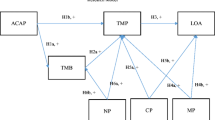Abstract
In light of new federal policies allowing hospitals to subsidize the cost of information systems for physicians, we examine the relationship between local hospital investments in information technology (IT) and physician EMR adoption. Data from two Florida surveys were combined with secondary data from the State of Florida and the Area Resource File (ARF). Hierarchal logistic regression was used to examine the effect of hospital adoption of clinical information systems on physician adoption of EMR systems after controlling for confounders. In multivariate analysis, each additional clinical IT application adopted by a local hospital was associated with an 8% increase in the odds of EMR adoption by physicians practicing in that county. Given this existing relationship between hospital IT capabilities and physician adoption patterns, federal policies designed to encourage this more directly will positively promote the proliferation of EMR systems.
Similar content being viewed by others
References
Bush, G. W., Executive Order. Incentives for the Use of Health Information Technology and Establishing the Position of the National Health Information Technology Coordinator. Code of Federal Regulations; 2004.
Ford, E. W., Menachemi, N., and Phillips, M. T., Predicting the adoption of electronic health records by physicians: when will health care be paperless? J. Am. Med. Inform. Assoc. 13:1106–112, 2006. doi:10.1197/jamia.M1913.
Brailer, D. J., The decade of health information technology: Delivering consumer-centric and information-rich health care. Washington, DC: Office for the National Coordinator for Health Information Technology; 2004.
Simon, J. S., Rundall, T. G., and Shortell, S. M., Drivers of electronic medical record adoption among medical groups. Jt. Comm. J. Qual. Patient Saf. 31:11631–639, 2005.
Menachemi, N., Barriers to ambulatory EHR: who are “imminent adopters” and how do they differ from other physicians? Informat. Prim. Care. 14:2101–108, 2006.
Conn, J., IRS approves IT subsidies: ruling means hospitals can underwrite doc EHRs. Mod. Healthc. 37:4, 2007.
Terry, K., Will relaxing Stark bind you tighter? Med. Econ. 83:340–43, 2006.
Conn, J., IT might be, IT could be, IT isn’t. Mod. Healthc. 37:1818–19, 2007.
Li, P., Bahensky, J. A., Jaana, M., and Ward, M. M., Role of multihospital system membership in electronic medical record adoption. Health Care Manage. Rev. 33:2169–177, 2008.
AHA: Continued Progress: Hospital use of information technology. Chicago, IL: American Hospital Association; February, 2007.
Jha, A. K., Ferris, T. G., Donelan, K. et al, How common are electronic health records in the United States? A summary of the evidence. Health Aff. (Millwood). 25:6w496–w507, 2006. doi:10.1377/hlthaff.25.w496.
Hirth, R. A., Chernew, M. E., and Orzol, S. M., Ownership, competition, and the adoption of new technologies and cost-saving practices in a fixed-price environment. Inquiry. 37:3282–294, 2000.
Kripalani, S., LeFevre, F., Phillips, C. O., Williams, M. V., Basaviah, P., and Baker, D. W., Deficits in communication and information transfer between hospital-based and primary care physicians: implications for patient safety and continuity of care. JAMA. 297:8831–841, 2007. doi:10.1001/jama.297.8.831.
Bates, D. W., Ebell, M., Gotlieb, E., Zapp, J., and Mullins, H. C., A proposal for electronic medical records in U.S. primary care. J. Am. Med. Inform. Assoc. 10:11–10, 2003. doi:10.1197/jamia.M1097.
Burton, L., Anderson, G., and Kues, I., Using electronic health records to help coordinate care. Milbank Q. 82:3457–481, 2004. doi:10.1111/j.0887-378X.2004.00318.x.
Menachemi, N., Hikmet, N., Stutzman, M., and Brooks, R., Investigating response bias in a health information technology survey of physicians. J. Med. Syst. 30:4277–282, 2006. doi:10.1007/s10916-005-9009-5.
Menachemi, N., and Brooks, R. G., EHR and other IT adoption among physicians: results of a large-scale statewide analysis. J. Healthc. Inf. Manag. 20:379–87, 2006.
Menachemi, N., Burke, D., Clawson, A., and Brooks, R. G., Information technologies in Florida’s rural hospitals: does system affiliation matter? J. Rural Health. 21:3263–268, 2005. doi:10.1111/j.1748-0361.2005.tb00093.x.
Menachemi, N., Burkhardt, J., Shewchuk, R., Burke, D., and Brooks, R., Hospital information technology and positive financial performance: a different approach to ROI. J. Healthc. Manag. 15:140–58, 2006.
Menachemi, N., Hikmet, N., Bhattacherjee, A., Chukmaitov, A., and Brooks, R. G., The effect of payer mix on the adoption of information technologies by hospitals. Health Care Manage. Rev. 32:2102–110, 2007.
Menachemi, N., Matthews, M. C., Ford, E. W., and Brooks, R. G., The influence of payer mix on electronic health record adoption by physicians. Health Care Manage. Rev. 32:2111–118, 2007.
Burke, D., and Menachemi, N., Opening the black box: measuring hospital information technology capability. Health Care Manage. Rev. 29:3210–217, 2004.
Furukawa, M. F., Ketcham, J. D., and Rimsza, M. E., Physician practice revenues and use of information technology in patient care. Med. Care. 45:2168–176, 2007. doi:10.1097/01.mlr.0000241089.98461.e5.
McKibbin, W., and Vines, D., Modelling reality: the need for both inter-temporal optimization and stickiness in models for policy-making. Oxf. Rev. Econ. Policy. 16:4106–137, 2000. doi:10.1093/oxrep/16.4.106.
Audet, A. M., Doty, M. M., Peugh, J., Shamasdin, J., Zapert, K., and Schoenbaum, S., Information technologies: when will they make it into physicians’ black bags? MedGenMed. 6:42, 2004.
Grant, R. W., Campbell, E. G., Gruen, R. L., Ferris, T. G., and Blumenthal, D., Prevalence of basic information technology use by U.S. physicians. J. Gen. Intern. Med. 21:111150–1155, 2006. doi:10.1111/j.1525-1497.2006.00571.x.
Acknowledgements
The hospital data for this study was collected in part by funding from Blue Cross Blue Shield Center for Rural Health Policy at the Florida State University College of Medicine. Physician data on EMR adoption was funded by the Center for Medicare and Medicaid Services (CMS), United States Department of Health and Human Services, Under Contract Number 500-02 FL02. No funding agency played any role in the study design, data collection, analyses, or interpretation of the data. The funding agency had no role in the preparation or submission of this manuscript. Thus, the ideas presented herein are solely those of the authors.
Author information
Authors and Affiliations
Corresponding author
Appendix
Appendix
Rights and permissions
About this article
Cite this article
Menachemi, N., Matthews, M., Ford, E.W. et al. The Relationship Between Local Hospital IT Capabilities and Physician EMR Adoption. J Med Syst 33, 329 (2009). https://doi.org/10.1007/s10916-008-9194-0
Received:
Accepted:
Published:
DOI: https://doi.org/10.1007/s10916-008-9194-0




